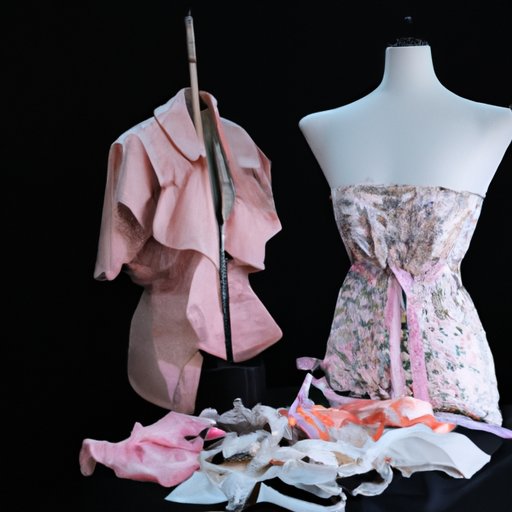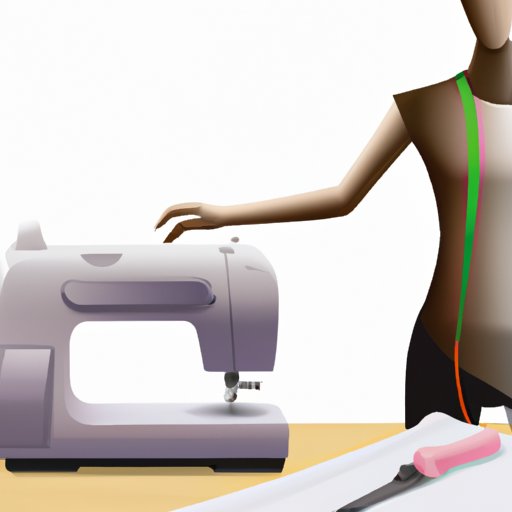

Introduction to Designing Your Own Clothes
Have you ever considered designing and creating your own clothing? Maybe you have a unique sense of style and struggle to find clothes that fit your preferences or figure. Or maybe you want to explore your creative side and develop a new skill. Whatever your reason, designing your own clothes can be fun and fulfilling. In this article, we’ll explore tips, techniques and inspiration for designing your own clothes, whether you’re a beginner or an experienced seamstress.
Deciding to Design Your Own Clothes
The decision to design your own clothes can be a big one, as it requires time, effort and dedication. Consider why you want to do it and set realistic goals for yourself. Are you looking to create a few pieces for yourself or start your own clothing brand? The level of commitment required for each may vary, so it’s important to establish your purpose and aim from the start.
Benefits of Designing Your Own Clothes
Designing your own clothes has several benefits. Firstly, you have complete control over the design process, from selecting fabrics to deciding on colors and patterns. This allows you to tailor clothing to your unique preferences and body type. Secondly, you can save money on expensive designer clothing or alterations. Thirdly, designing your own clothes can be a therapeutic and creative outlet that provides a sense of accomplishment and pride.
Audience and Purpose of the Article
This article caters to anyone interested in designing their own clothes, regardless of skill level. Whether you’re a beginner seamstress or an experienced fashion designer, you’ll find tips, techniques and inspiration to guide you through the design process. The article also aims to inspire creativity, confidence and independence in designing and creating clothing that is uniquely your own.
5 Essential Tips for Designing Your Own Clothes
If you’re new to designing your own clothes, it can be overwhelming to know where to start. Here are five essential tips to help you get started:
Tip #1: Sketch and Plan Your Design
Before you start cutting or sewing, it’s essential to sketch and plan your design. Use a sketchbook or drawing paper to draw out your design, including details such as fabric type, colors, patterns and silhouettes. This will help you visualize the final product and identify any potential design flaws.
Tip #2: Take Measurements Accurately
Accurate measurements are crucial to ensure a proper and comfortable fit for your clothing. Use a measuring tape to take your measurements, including bust, waist, hips, inseam, arm length and shoulder width. It’s also essential to measurer your garment’s intended wearer to ensure a perfect fit.
Tip #3: Start Small and Simple
When starting out, it’s important to keep your designs simple. Starting with basic designs such as a skirt or a simple top allows you to get comfortable with the design and sewing process before moving on to more complex designs. Once you feel more confident, you can start experimenting with more complicated cuts and designs.
Tip #4: Focus on Fit and Comfort
A great design means nothing if the garment doesn’t fit well or isn’t comfortable to wear. When designing your clothing, focus on creating a garment that flatters the wearer’s body and is comfortable to move in. Consider the drape and fabric weight, too; a heavy fabric might be constricting, whereas a lighter fabric may be too revealing and see-through.
Tip #5: Use High-Quality Materials
The quality of your fabric plays a significant role in the overall quality of your clothing. Using high-quality materials ensures a long-lasting garment that looks and feels great. High-quality material is usually the natural, unblended fibres which are good for the environment and wear well. It’s also important to invest in high-quality thread and sewing supplies such as shears, pins, and needles.
The Creative Process of Designing Custom Clothing: Step by Step
Designing a piece of clothing is a creative process that involves several steps. Here’s a breakdown of the process:
Brainstorming and Conceptualizing
The first step is coming up with a design concept that appeals to your personal style or brand identity. Start by brainstorming and collecting inspiration from fashion websites, art exhibitions, and fashion trade shows.
Inspiration and Research
Once you have a concept in mind, research existing styles and trends that reflect your vision. This step can help you identify ways to improve or differentiate your designs, and help you learn about current and future trends.
Sketching and Drawing
Once you have a clear concept and direction for your designs, start sketching and drawing your designs. Begin with rough sketches and refine your drawings as you go. Continue to improve the design until you are satisfied with the results. This stage might require several iterations.
Drafting and Pattern-making
Use your sketches to create pattern pieces that will form the basis for your garment. Use pattern drafting software like ‘Valentina’, or trace clothing pieces you already own, making any necessary modifications.
Cutting and Sewing
Once you have your pattern, select your fabric, cut your pattern pieces, and sew the garment together according to the pattern. Use instructions specific to the garment type, ensuring that you follow step by step instructions carefully.
How to Choose the Right Fabrics for Your Clothing Design
Choosing the right fabrics for your clothing design is essential to ensure a comfortable and high-quality garment. Here are some things to consider when choosing fabric:
Types of Fabrics and their Characteristics
Fabrics come in various forms, from natural to synthetic, plain to patterned. Being familiar with the most commonly used fabrics will help you choose the perfect material for your design.
Fabric Considerations for Different Types of Apparel
The type of apparel you are designing will influence the fabric you choose. A heavy fabric works for skirts and pants but might be too bulky for a dress while silk suits a dress or blouse, but not a jacket. Also, consider weather conditions and how well your fabric will handle sweat or the rain.
Tips for Purchasing Fabric
Purchasing fabric may seem straightforward, but it’s essential to choose the right fabric for your design and budget. Set a budget, read labels and reviews, order swatches, and consider whether the fabric can be washed with ease or if it requires special care. Don’t forget to check motifs and prints and placement if it concerns you before purchasing the fabric.
Breaking into the Fashion Industry: Tips for Designing and Marketing Your Collection
The fashion industry is evergreen and offers countless opportunities to showcase your creativity, design skills and establish your own brand. Here are some tips on how to break into the fashion industry:
Creativity and Originality
Original ideas are key to establishing a unique brand and attracting customers. Research prevailing trends and customize them to suit current lifestyles and cultures.
Developing a Brand Identity
Establishing a brand identity that resonates with your customers is crucial. Your brand identity should encompass your brand’s essence, values, personality and inspiration behind your designs.
Networking and Building Relationships
Networking with industry experts and building relationships with influencers in your target markets can increase the visibility of your brand. Attend trade shows, fashion weeks, and other relevant events, and share your work so that people discover you.
Effective Marketing Strategies
Marketing is essential to reach your target market. Showcase your designs on your website or e-commerce platforms; these should be well-designed and fully optimised. Use social media, run ad campaigns, giveaways and sales promotions to further boost your brand’s visibility and your sales.
From Sketch to Sew: A Beginner’s Guide to Designing Clothes
For beginners in designing clothes, here’s a beginner’s guide to help you get started:
Tools and Supplies Needed
Some essential tools and supplies you’ll need include a sewing machine, fabric, thread, shears, seam ripper, measuring tools, and a cutting mat.
Basic Terminology
Understanding basic industry terms and concepts is essential in designing clothes. Some of the important ones include pattern drafting, cutting, and sewing techniques, as well as the different types of fabric, and their grainline.
Step-by-step Guide to Designing and Sewing a Basic Garment
Start with a small design, using a basic pattern or tracing a simple garment you already have. Follow the pattern step-by-step, cutting fabric, sewing, and assembling until you have a finished garment. With time, you can create and master more intricate pieces.
Innovative Techniques for Designing Clothing Patterns and Styles
Designing clothing patterns involves an array of specialist techniques. Here are some innovative techniques to enhance your garment cutting and design skills:
Specialty Fabrics and Materials
Specialty fabrics and materials such as pleather (plastic leather), tulle, neoprene, or lace allow you to create unique finishes, adding texture and depth to your garments. Identifying new materials to incorporate into your future designs can keep your work versatile and attractive.
Designing for Different Body Types
Designing for different body types isn’t only an excellent way to advance your skills but also helps you design pieces that appeal to a wider audience. Study body types and make appropriate adjustments to your designs to flatter specific body shapes better.
Manipulating Fabrics and Patterns
Manipulating fabrics and patterns allows you to create designs with unique shapes and textures. Techniques for manipulating fabrics include pleating, gathering, ruching, shirring, and folding, which can all add a unique twist to your signature style.
Designing Clothes That Fit Your Unique Style and Personality
Designing your clothes should be fun and fulfilling. Follow these tips to make your designs a reflection of your unique style and personality:
Embracing Your Personal Style
Design clothes that match your personal style rather than making pieces for other people’s tastes. Use colors and fabrics you love to create pieces that will make you feel confident and comfortable when you wear them.
Incorporating Trends
While it’s important to follow your personal style, it’s also important to stay up to date with current fashion trends. Incorporating current trends into your designs can give the garments a sense of relevance and a wider appeal while keeping the unique signature style of your designs.
Customizing Designs to Fit Your Personality
Customizing your designs to fit your personality is a great way to make your pieces unique. Add your signature to the designs by incorporating details like buttons, trims, or unique zippers.
Conclusion
Designing your own clothes may seem like a daunting task, but with time and practice, it can be fulfilling and enjoyable. Follow these tips and techniques, start small, and keep honing your skills. Embrace your creativity and uniqueness, and before you know it, you’ll have your brand, and people will be loving your custom fashion line. Keep learning and refining your skills, and embrace the journey of designing your own clothes!
Additional Resources for Learning More About Designing Clothes
For those interested in learning more about designing clothes, there are countless resources available. Check out online courses, YouTube tutorials, and sewing blogs for more information and inspiration. Informative websites and books about pattern drafting, sewing techniques, and fashion history, as well as fashion magazines, are also great resources.




